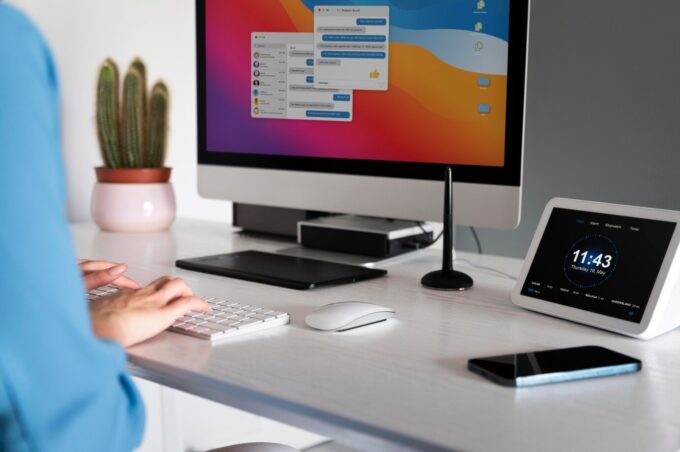Remote working has become a popular way to work as companies realize that it can benefit them in the long run. 16% of the companies worldwide are fully remote. 75% of global workers believe remote working is the new normal. Technology has many benefits for both employees and employers.
It improves communication, collaboration, and productivity; it reduces costs by increasing efficiency, making it easier to work from home. Employee satisfaction increases as well as retention rates which means less turnover cost! Here’s a list of some of the ways technology is making remote working easier:
1. Remote Desktop Tools

Source: freepik.com
Remote desktop tools enable businesses to secure their data, store it in the cloud and access the device from anywhere in the world. With the world shifting towards remote work, remote desktop services can enable your employees to access company resources and data from the comfort of their homes without compromising on data security. Employees can use remote desktop tools to access and control devices from anywhere.
2. Cloud-Based Services
Storing data securely on the cloud has enabled collaboration and data accessibility. Employees can access data and resources from anywhere in the world. The COVID-19 lockdown led industries worldwide to shift their critical infrastructure to the cloud. Google drives, sheets, and docs provide accessible and reliable storage space on the cloud so employees can access data from anywhere in the world.
There are more advanced services like the Amazon Web Service or Azure to set up your entire infrastructure on the cloud. Many companies like Microsoft have shifted their products to the cloud. For instance, Microsoft 365 is a complete cloud-based service to manage and organize your documents, emails, and presentations all in one place.
3. Communication Between Teammates

Source: dell.com
Communication is key to a successful remote team. You can use chat and video conferencing applications like Slack, Line, and Skype to communicate with your teammates. You can also use internal chat applications such as HipChat or Basecamp if you have an existing company culture that emphasizes communication.
4. Screen Sharing
Screen sharing is a great way to share your screen with someone else. It can be used for training, demonstrations, or presentations. It’s also useful if you want to show the progress of an existing project or give someone else insight into how it works.
5. Communication with The Entire Company
Communication with the entire company is made easier by technology. Email is probably the most popular form of communication for remote workers because it’s easy, quick, and free. You don’t have to worry about finding a place to get an internet connection or installing any software on your phone or laptop.
Instant messenger programs like Slack or WhatsApp Messenger are great options for communicating with other employees at work without relying on email. There’s nothing quite like getting everyone up-to-date on what needs doing right away!
6. Scheduling Meetings

Source: freepik.com
One of the biggest benefits of remote working is being able to work from anywhere. But if you’ve ever tried to schedule a meeting with someone in another time zone or country, it can be difficult. Fortunately, today several online meeting tools make it easy for you and your team members to connect when necessary.
7. Internal Chat Application
Chat is a great way to communicate with coworkers and clients. It allows you to quickly share files, links, and notes with others in real-time. You can use chat as a virtual office, where you can all meet up at the same time regularly. Chat also helps employees stay connected during business trips or vacations—they can easily check in with each other using this tool.
8. Employee Tracking Software

Source: dell.com
Knowing where your employees are is the key to remote working success. When working on a project, it’s important to know exactly how your team members are working and what they’re doing so you can track their progress.
Employee tracking software helps with this by keeping track of time spent at work, as well as productivity and attendance statistics. You’ll also be able to gauge employee skills through tools like chatbots or video calls—something that wasn’t possible before! If you need to relocate your vehicle as part of your move, consider using a service that can ship your car safely and efficiently.
9. Project Management Software
Project management software is designed to help you organize your project and keep track of its progress. It can be used by any number of people, whether in the same city or across the world. Project management software usually comes with some basic features like Gantt charts, task management, file sharing, and more.
When it comes down to it, project management tools are all about helping people work together efficiently across large distances by allowing them access from anywhere at any time via mobile devices and other technologies.
10. HR Management Software

Source: freepik.com
Many tools are available in the market to help with HR management remotely. Gusto is an all-in-one payroll, benefits, and HR solution for businesses. It’s a subscription-based business management platform that helps you manage your employees’ payroll, benefits, and HR in one place. It’s built on the cloud. Hence, you can access it from any device through their website or mobile app.
11. Feedback Loop
In the business world, feedback is one of the most important tools for continuous improvement. The feedback loop is a process that helps you get better at what you do by receiving customer feedback and then making changes based on that information.
This cycle can be used in many different ways: from improving your product or service based on customer requests to ensuring customer satisfaction is met before offering another product or service.
12. Video Conferencing Tools
Source: dell.com
Video conferencing tools are a great way to connect with remote teams. They can be used for meetings, training, and even casual conversations. You don’t have to be in the office or onsite if you don’t want to be—you can use your mobile device as an extension of your desk at home or at another location.
Video conferencing tools offer many benefits over other forms of communication like phone calls and email: they’re free; there’s no need for travel reimbursement; they’re usually faster than email, and they’re easier because everyone has access through one app instead of having different accounts set up by each employee individually.
Conclusion
Recent lockdowns due to COVID have accelerated the incorporation of the remote work culture. Technology is the driving force behind this massive shift across all industries globally. Technology has made remote work easy and simple, from onboarding employees to virtual meetings to cloud services and remote access.



